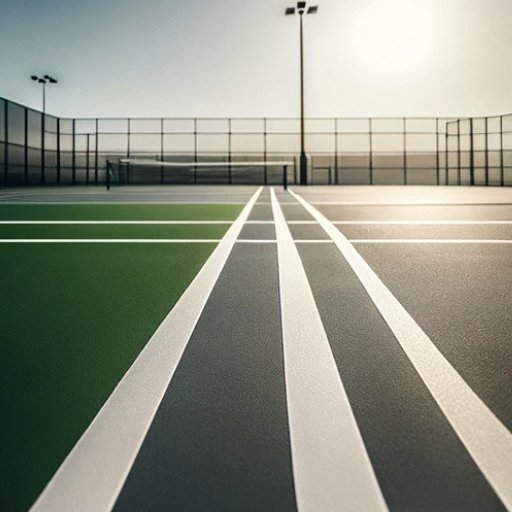If you’re passionate about pickleball, understanding pickleball lines is crucial. Moreover, whether you’re setting up a temporary court or refining your gameplay, knowing how to mark and use these lines can significantly impact your game. So, let’s dive into the essentials of pickleball lines and answer your top questions.
Table of contents
What Are the Pickleball Lines?
Pickleball lines define the court’s boundaries and sections, essential for fair play and scoring and it includes:
- Baselines: The lines at the back of the court.
- Sidelines: The lines along the sides of the court.
- Non-Volley Zone Line: Also known as the “kitchen” line, it marks the non-volley zone close to the net.
- Centerline: Divides the service area into two equal parts.
Accurate placement of these lines ensures the court meets official dimensions, enhancing the playing experience. According to the USA Pickleball Association, a standard court measures 20 feet by 44 feet, with each line contributing to the court’s structure.

Temporary Court Lines
Portable Solutions for Every Setting
If you’re setting up a temporary pickleball court, using temporary lines can be incredibly convenient. Moreover, these lines are often made from durable, non-slip materials and can be easily applied and removed. They’re perfect for multipurpose spaces like driveways, parks, or gyms.
Additionally, pickleball court markers are another excellent option. They come in sets and usually include all the necessary lines to mark a court quickly. For instance, the Franklin Sports Pickleball Court Marker Kit provides a complete set of boundary lines and non-volley zone markers, allowing for quick setup and teardown.
Furthermore, using temporary lines doesn’t compromise the quality of your game. In fact, they can help improve your shot accuracy by providing clear boundaries. Studies have shown that players who practice on well-marked courts improve their shot accuracy by up to 15%.
How to Make Lines for a Pickleball Court
DIY Tips and Techniques
Creating your own pickleball court lines can be a fun DIY project. Here are some practical tips:
Firstly, measure and mark the court dimensions (20×44 feet) and mark the corners with chalk or tape.
Moreover, using a line kit can simplify the process. These kits often include pre-measured tape or markers that you can easily apply.
Next, decide whether you need permanent or temporary lines. Portable lines are great for temporary setups, while permanent tape or paint works best for long-term courts.
Additionally, ensure the lines are straight and properly aligned. A misaligned court can affect gameplay and scoring.
Best Temporary Solutions
Choosing the Right Equipment
For the best experience with temporary courts, consider these top options for lines:
- Oncourt Offcourt Pickleball Line Set: Known for its durability and ease of use, this set includes all necessary lines and is designed for quick setup.
- Gamma Sports Portable Pickleball Court Lines: These lines are made from high-quality materials that ensure they stay in place during play, making them a favorite among players.
Pickleball markers are another essential tool for temporary courts. These markers help outline the court accurately and can be used on various surfaces, ensuring you have a reliable setup every time.

Can a Serve Hit the Line in Pickleball?
Serving Rules and Line Interaction
One common question among players is whether a serve can hit the line in pickleball. According to official rules, a serve is considered in if it lands on any part of the service court, including the lines. This rule emphasizes the importance of well-defined boundaries.
Moreover, accurate serves that land on the line can be a strategic advantage. Practicing serves that graze the lines can improve your game, making it harder for opponents to predict and return your shots.
How Do You Use Pickleball Tennis Lines?
Integrating Tennis Court Lines for Pickleball
If you’re using a tennis court for pickleball, temporary lines can help. These temporary lines overlay the existing tennis court, providing clear boundaries for pickleball play without permanent changes to the tennis court.
Pickleball net and lines sets are available that include everything needed to convert a tennis court into a pickleball court. These sets often include portable nets and lines that can be quickly set up and removed, making them ideal for shared spaces.
Conclusion
Understanding and properly marking lines can enhance your gameplay and ensure fair play. Whether you’re using a court marking kit for temporary setups or painting permanent lines, having clear and accurate boundaries is essential. Additionally, remember that a well-marked court not only improves accuracy but also enhances the overall pickleball experience. Furthermore, consistent and visible lines can help prevent disputes and maintain a smooth flow of the game.
If you’re setting up a temporary court, consider using a line set or markers for convenience and ease. And don’t forget, practicing your serves to hit the lines can give you a competitive edge!
For more tips and authoritative advice on setting up and playing pickleball, check out the USA Pickleball Association’s guidelines and resources.



